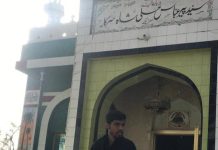Lahore: Most visits to public hospitals, police stations, and schools turns into a nightmare. This is the argument the Centre for Public Policy and Governance at the Forman Christian College Lahore made in its report on, “Improving Governance, Reforming Provincial Civil Services in Punjab.”
According to the report, 80 per cent of the public service officials are employed from grade 1 to 16. Nurses, elementary teachers, lady health workers, Station Head Officer, Patwari (Land Record Clerk), and similar jobs fall into this category. The report defines them as the ‘Faces of the State’ and argues that no policy initiative could ever be successful unless these public officials are consulted or taken into account at the policy formulation stage. It is these people, says the report, who implement policies.
Alia Butt is a housewife. Her mother has been hospitalized for the last month in Services Hospital Lahore suffering from a renal problem. Butt says their worst experience starts when they have to interact with the nurses. She told News Lens that the nurses are easily angered.
When News Lens Pakistan consulted with the nurse, who would only speak anonymously, she said that due to excess workload and bad behavior of the senior nurses and, at times, of doctors, they lose the spirit to work selflessly.
According to the CPPG survey, normally one nurse should serve 11 patients. In reality, however, in a single ward, one nurse is serving 40 patients. Researchers noted a general apathy of policymakers in terms of capacity building and developing human resource capacity of the supporting health care staff.
News Lens Pakistan went to Punjab Health Commission and met Dr Riaz Tasneem, the senior consultant and program director at PHC. Talking about the behavior of the doctors and nurses, he said it was unfortunate that a profession as noble as the doctor had become a source of distress for the general public. When the government left medical treatment at the mercy of the private sector, greed, indifference, and amateurism became the norm, Tasneem said.
Another area that holds equal importance in the lives of the general public is the police department. The first encounter of any complainant usually takes place with the Station Head Officer (SHO). New Lens Pakistan contacted an SHO of a local police station in Lahore who wished go unnamed to avoid the wrath of his higher-ups.
Talking about the behavior of the constables and a general complaint that police in Punjab are too brutal and headstrong, the SHO said that long duty hours and lack of resources had made their professional lives a burden.
For example, if the police van breaks down, they have to arrange resources from among themselves to get the van fixed, because if they waited for the administrative department to send the money, it would take a lot of time and hinder their work, he said.
The report also talks about the lack of workforce at the police station. According to the Police Rule 1879, there should be one constable to 456 people. In reality, there is one constable to 1,000 people. The officer further said that when Dolphin force was made, instead of recruiting new police officers, officers from the current force had been drawn and converted into the Dolphin force, a special squad to control street crimes. It created a further shortage.
When News Lens Pakistan talked to the Deputy Inspector General of Police (Operations) Lahore Haider Ashraf, he acknowledged that there was a severe shortage of constables and other police officers at the junior level. However, because of lack of funds new officers could not be recruited, he said.
When asked about long working hours, resulting in fatigue and unprofessionalism, Ashraf stated that Pakistan is not in Europe and that police should not expect an eight-hour shift. “The officers have to work for at least for 12 hours on duty,” said Ashraf.
The ratio of police officers to citizens in Punjab is 1:529. The ‘Punjab Police Rules (1934) limit it at 1:450. The ‘Police Act 1861’, which remains the guiding framework for lawmaking in the police, had mandated 1:6 ratio.
Amna Mushtaq works in a local government school. Narrating her ordeal, she said she had to handle 50 children at one time. “How is it expected that I would perform professionally?”
She lamented that since she teaches four subjects, checking the copies and papers of so many children becomes an endless chore. “When I entered this profession, I had the spirit to serve the community, but now it is all about managing workload and keeping my job intact,” she said.
When Truth Tracker asked Mian Mujtaba Shuja-ur-Rehman, Punjab Excise and Taxation and Higher Education Minister, about the grievances of the teachers, he said the government is doing its best to spread education among the masses.
According to the research report, 36 percent children in Punjab are out of school and 69 percent drop out of school by the age of five. The reasons given for such a dismal state vary from lack of trained teachers to deficient teaching material to poor infrastructure.
Saeed Shafqat, the originator of the idea behind the research, said that the government had been emphasizing reform of the higher bureaucracy. However, there is a dire need to reform the street-level bureaucrats. “It is here that the general public receives redress to their problems and issues,” said Shafqat.



